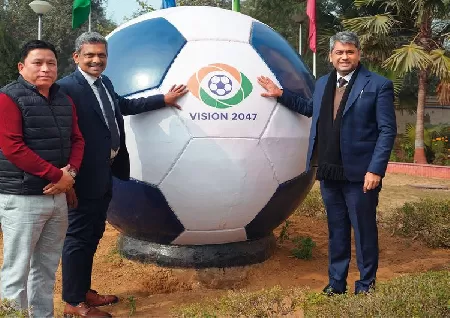Indian football has Vision 2047 but does it have the legs

It will need a sizable and persistent commitment from business and industry to achieve even half of the first set of goals.
The 24-year strategy road map for the All India Football Federation, "Vision 2047," has a name to express its tone. That would be "truthful." The 94-page road map clearly outlines the state of Indian football. We are not the slumbering behemoth that needs to be stirred into greatness by trumpet blasts and cymbal crashes. hosting FIFA Junior World Cups, for example. Franchise leagues can also be thought of from the top down.
The current state of Indian football includes a "insufficiency of games at the elite level," "lack of a defined pathway between grassroots and youth structure," "weak competitive structure of youth football," "low level of state and district matches," "insufficiency of sustainable livelihood options," "low levels of economic return creating a hindrance to career adoption across levels"
"short-term outlooks insufficient investment in creating infrastructure," and "short-term outlooks insufficient investment in youth football." The AIFF claims that our sport's "short league duration and significantly fewer domestic encounters across the pyramid" are "detrimental to the ideal development of players."
This was well known, frequently discussed, and bemoaned across Indian football; yet, it is a comfort that the governing body has acknowledged it and put it down without reservation. More reality checks are provided by a series of incredibly challenging images. The quantity of teams or games in a nation's top league correlates with the level of its national performance. The top 20 men's teams in the world average 17.6 teams in their top league, giving their players more opportunities to play each season. The average number of matches played by men per season in India is between 20 and 24, compared to 30 to 34 for the vast majority of men worldwide. The top 20 nations have an average of 11.3 teams in the women's division.
With a promise of 15 clubs in 2022–23, the Indian Women's League will have more teams than the 12 in England. The women in India play 10–14 matches on average per season, which is more than the men do and is similar to the average across 45 other nations. The future of Indian football must be female, as this column has stated in the past.
Thankfully, there aren't any great declarations in Vision 2047 like there were when Praful Patel was president of the AIFF. India's "objective" for the WC2026 was to qualify for the 2022 World Cup, which it "should strive" to do. The second Patel story grab favourite, which involved committing to pitch for the U-20 World Cup3 in order to qualify for the event, is left out. Be praised. Any 24-year plan, however, is susceptible to becoming amorphous.making it challenging to follow. However, by dividing the 24 years into six chunks of four years, we have at least been given the first four years' worth of goals to keep us on track.
The To-Do by 2026 list includes a number of difficult goals, including having 40 professional men's football clubs operating at the top three tiers of a five-tiered pyramid (14 teams in the ISL, 14 in the I League-I, and 12 in the I League-2). The bottom rung of the pyramid is made up of 60 distinct municipal or district leagues, which feed into five zonal leagues and state championships.
By 2026, it is intended to reach 35 million children and have 1 million registered players (as opposed to the 146,900 registered as of this writing). Additional features include a core centre for youth referee training, 700 development clubs, 35 games played by each young player in the elite and youth divisions, youth teams that are required for all professional clubs, and more.
This is based on a quick glance at Vision 2047. There is no doubt that those who are much more directly involved with Indian football can provide a very logical and detailed evaluation. The area of marketing and commercialization will be the one that is most closely examined in terms of being the first layer of viability. The estimated annual budget for the AIFF is Rs 80.
Financing the necessary competition mechanisms in such a large country is difficult because the price per crore is "much cheaper than peers in Asia." The AIFF wants to create three flagship television properties by 2026 and expects its revenue to rise by 500%.
This is where Kalyan Chaubey, the president of the AIFF and a former professional goalie who is a member of the governing BJP, is supposed to play a part. Industry and business must make a sizable and persistent investment to achieve even half of the 2026 objectives. Due to his political ties, Chaubey is now in the ideal position to find, connect with, or develop new stakeholders for Indian football. We frequently hear that as the justification for why having politicians in sports management is beneficial.
Indian football is a current example of the claim.
Contrary to our cricket, which, against popular belief, does not now require or have a marketing whiz running the BCCI, Indian football is currently politely referred to as "s**t or bust," which means to go all in or risk sinking. To bring its divided membership—states, clubs, and egos—together, it will need professionalised management and forward-thinking administrators, as well as perhaps a little political clout. to advance and join the environment of contemporary football without shouting "World Cup" every four years And possibly demonstrate to other federation brethren what Indian sport can achieve with largely professionalised management and reassuringly sound governance.
Related queries to this article
- 24-year strategy road map
- state of Indian football
- All India Football Federation
Read more articles and stories on InstaSity Latest News.